Second Battle of Ypres
| ||||||||||||||||||||||||||||
During World War I, the Second Battle of Ypres was fought from 22 April – 25 May 1915 for control of the strategic Flemish town of Ypres in western Belgium after the First Battle of Ypres the previous autumn. It was the first mass use by Germany of poison gas on the Western Front. For the first time, a former colonial force (the 1st Canadian Division) defeated a European power (the German Empire) on European soil (in the battles of St. Julien and Kitcheners' Wood, engagements during the battle).
Background
The battle consisted of six engagements:
- Battle of Gravenstafel: Thursday 22 April – Friday 23 April 1915
- Battle of St. Julien: Saturday 24 April – 4 May
- Battle of Frezenberg: 8–13 May
- Battle of Bellewaarde: 24–25 May
- Battle of Hooge 30–31 July 1915 (first German use of flamethrowers)
- Second Attack on Bellewaarde 25 September[5]
The Ypres salient followed the canal, bulging eastward around the town. North of the salient, the Belgian army held the line of the Yser, and the northern end of the salient was held by two French divisions.[6] The eastern part of the salient was defended by one Canadian and two British divisions. The II Corps and V Corps of the Second Army comprised the 1st, 2nd and 3rd Cavalry Divisions and the 4th, 27th, 28th, Northumbrian, Lahore and 1st Canadian Divisions.[7]
Battle
Battle of Gravenstafel Ridge (22–23 April 1915)
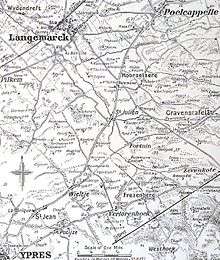
In the hamlet of Gravenstafel (50°53′28″N 2°58′44″E / 50.891°N 2.979°E) at about 5:00 p.m. on 22 April, the German Army released 168 long tons (171 t) of chlorine gas over a 6.5 km (4.0 mi) front on the line held by French Territorial and colonial Moroccan and Algerian troops of the French 45th and 87th divisions.[8] Although poison gas had been used before, at the Battle of Bolimów three months earlier, the gas had liquified in the cold and become inert.
German troops carried 5,730 gas cylinders, weighing 90 pounds (41 kg) each, to the front by hand. The cylinders, opened by hand, relied on the prevailing wind to carry the gas towards enemy lines. Because of this method of dispersal, a large number of German soldiers were injured or killed while carrying out the attack.[9]
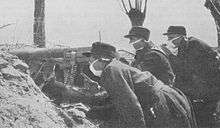
The French troops in the path of the gas cloud sustained about 6,000 casualties. Many died within ten minutes (primarily from asphyxia and tissue damage in the lungs), and many more were blinded. Chlorine gas forms hypochlorous acid when combined with water, destroying moist tissue such as the lungs and eyes. The chlorine gas, denser than air, quickly filled the trenches and forced the troops out into heavy enemy fire.[10]
Although many French troops ran for their lives, others stood their ground and waited for the cloud to pass. Field Marshal Sir John French, Commander-in-Chief of the British Army, wrote:
... I wish particularly to repudiate any idea of attaching the least blame to the French Division for this unfortunate incident. After all the examples our gallant Allies have shown of dogged and tenacious courage in the many trying situations in which they have been placed throughout the course of this campaign it is quite superfluous for me to dwell on this aspect of the incident, and I would only express my firm conviction that, if any troops in the world had been able to hold their trenches in the face of such a treacherous and altogether unexpected onslaught, the French Division would have stood firm.[11]
Anthony R. Hossack of the Queen Victoria's Rifles described the chaos as the French Colonial Corps troops fled from the gas:
Plainly something terrible was happening. What was it? Officers, and Staff officers too, stood gazing at the scene, awestruck and dumbfounded; for in the northerly breeze there came a pungent nauseating smell that tickled the throat and made our eyes smart. The horses and men were still pouring down the road. two or three men on a horse, I saw, while over the fields streamed mobs of infantry, the dusky warriors of French Africa; away went their rifles, equipment, even their tunics that they might run the faster. One man came stumbling through our lines. An officer of ours held him up with levelled revolver, "What's the matter, you bloody lot of cowards?" says he. The Zouave was frothing at the mouth, his eyes started from their sockets, and he fell writhing at the officer's feet.[12]
A 4-mile (6.4 km) gap was left in the front line. The German High Command had not foreseen the effectiveness of the new weapon and all available troops had been transferred to Russia, leaving few reserves in the west. General von Falkenhayn, Chief of the German General Staff, had ordered the attack as a limited effort by the German 4th Army.[13] German troops advanced at 5:00 p.m., but dusk, apprehension about the effect of the gas and the lack of reserves prevented the Germans from exploiting the gap more significantly.[14] Canadian troops defended the flank of the break-in by urinating into cloth and holding them to their faces to counter the effects of the gas. Casualties were especially heavy for the 13th Battalion of the Canadian Expeditionary Force (CEF), which was enveloped on three sides and over-extended in securing its left flank when the Algerian Division broke.[15]
At Kitcheners' Wood, the 10th Battalion of the 2nd Canadian Brigade was ordered to counter-attack in the gap created by the gas attack. They formed up after 11:00 p.m. on 22 April, with the 16th Battalion (Canadian Scottish) of the 3rd Brigade arriving to support the advance. Both battalions attacked with over 800 men, in waves of two companies each, at 11:46 p.m. Without reconnaissance, the battalions ran into obstacles halfway to their objective; engaged in small-arms fire from the wood, they began an impromptu bayonet charge. The attack cleared the former oak plantation of Germans at a 75-percent casualty rate.[16]
The Germans set fire to a chemical product of sulphur chloride which they had placed in front of their own trenches, causing a thick yellow cloud to be blown towards the trenches of the French and Belgians. The cloud of smoke advanced like a yellow low wall, overcoming all those who breathed in poisonous fumes. The French were unable to see what they were doing or what was happening. The Germans then charged, driving the bewildered French back past their own trenches. Those who were enveloped by the fumes were not able to see each other half a yard apart. I have seen some of the wounded who were overcome by the sulphur fumes, and they were progressing favourably. The effect of the sulphur appears to be only temporary. The after-effects seem to be a bad swelling of the eyes, but the sight is not damaged.[17]— The Daily Mail (26 April 1915)
Dusk was falling when from the German trenches in front of the French line rose that strange green cloud of death. The light north-easterly breeze wafted it toward them, and in a moment death had them by the throat. One cannot blame them that they broke and fled. In the gathering dark of that awful night they fought with the terror, running blindly in the gas-cloud, and dropping with breasts heaving in agony and the slow poison of suffocation mantling their dark faces. Hundreds of them fell and died; others lay helpless, froth upon their agonized lips and their racked bodies powerfully sick, with tearing nausea at short intervals. They too would die later – a slow and lingering death of agony unspeakable. The whole air was tainted with the acrid smell of chlorine that caught at the back of men's throats and filled their mouths with its metallic taste.[17]— Captain Alfred Oliver Pollard, The Memoirs of a VC (1932)
Battle of St. Julien (24 April – 5 May)
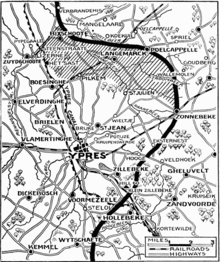
The village of St. Julien (now Sint-Juliaan; 50°53′24″N 2°56′13″E / 50.890°N 2.937°E) was in the rear of the 1st Canadian Division until the poison-gas attack of 22 April, when it became the front line (see trench map). Some of the first fighting in the village involved the stand of lance corporal Frederick Fisher of the 13th Battalion CEF's machine-gun detachment; Fisher went out twice with a handful of men and a Colt machine gun, preventing advancing German troops from passing through St. Julien into the rear of the Canadian front line. He was killed the following day.[18]
On the morning of 24 April, the Germans released another gas cloud towards the re-formed Canadian line just west of St. Julien. Word was passed to the troops to urinate on their handkerchiefs and place them over their nose and mouth.[19][Note 1] The countermeasures were insufficient, and German troops took the village.[21] The next day the York and Durham Brigade units of the Northumberland Division counter-attacked, failing to secure their objectives but establishing a new line closer to the village.[22] On 26 April the Northumberland Brigade attacked again and gained a foothold in the village, but were forced back with the loss of more than 1,940 casualties.[23] Despite hundreds of casualties, the 2nd Royal Dublin Fusiliers participated without respite in the battles at Frezenberg and Bellewaarde. On 24 April the battalion, subjected to a German gas attack near St. Julien, was nearly annihilated.
The German Army first used chlorine-gas cylinders in April 1915 against the French Army at Ypres,[Note 2] when yellow-green clouds drifted towards the Allied trenches. The gas had a distinctive odor, resembling pineapple and pepper. The French officers, assuming at first that the German infantry were advancing behind a smoke screen, alerted the troops. When the gas reached the front Allied trenches, soldiers began to complain of chest pains and a burning sensation in the throat.
Capt. Francis Scrimger of the 2nd Canadian Field Ambulance may have passed the order to use urine to counteract the gas, on the advice of Lt.-Col. G.G. Nasmith (see note 10). Soldiers realised they were being gassed, and many ran as fast as they could. An hour after the attack began, there was a 1,500 yards (1,400 m) gap in the Allied line.[24] Fearing the chlorine, few German soldiers moved forward and the delay enabled Canadian and British troops to retake the position before the Germans could exploit the gap.[25]
After the first German chlorine-gas attacks, Allied troops were supplied with masks of cotton pads soaked in urine; it had been discovered that the ammonia in the pad neutralized the chlorine. The pads were held over the face until the gas dispersed. Other soldiers preferred to use a handkerchief, sock or flannel body-belt, dampened with a sodium-bicarbonate solution and tied across the mouth and nose, until the gas passed. Soldiers found it difficult to fight like this, and attempts were made to develop a better means of protection against gas attacks.[26] By July 1915, soldiers received efficient gas masks and anti-asphyxiation respirators. Private W. Hay of the Royal Scots arrived in Ypres just after the chlorine-gas attack on 22 April 1915:[26]
We knew there was something was wrong. We started to march towards Ypres but we couldn't get past on the road with refugees coming down the road. We went along the railway line to Ypres and there were people, civilians and soldiers, lying along the roadside in a terrible state. We heard them say it was gas. We didn't know what the Hell gas was. When we got to Ypres we found a lot of Canadians lying there dead from gas the day before, poor devils, and it was quite a horrible sight for us young men. I was only twenty so it was quite traumatic and I've never forgotten nor ever will forget it.[17]— Private W. Hay of the Royal Scots
The French soldiers were naturally taken by surprise. Some got away in time, but many, alas! not understanding the new danger, were not so fortunate, and were overcome by the fumes and died poisoned. Among those who escaped nearly all cough and spit blood, the chlorine-attacking the mucous membrane. The dead were turned black at once. About 15 minutes after letting the gas escape the Germans got out of their trenches. Some of them were sent on in advance, with masks over their heads, to ascertain if the air had become breathable. Having discovered that they could advance, they arrived in large numbers in the area on which the gas had spread itself some minutes before, and took possession of the arms of the dead men. They made no prisoners. Whenever they saw a soldier whom the fumes had not quite killed they snatched away his rifle and advised him to lie down "to die better."[17]— The Daily Chronicle (26 April 1915)
Battle of Frezenberg (8–13 May)
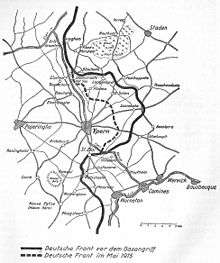
The Germans moved field artillery forward, placing three army corps opposite the 27th and 28th Divisions on the Frezenberg ridge (50°52′05″N 2°57′00″E / 50.868°N 2.950°E).[27] The German attack began on 8 May with a bombardment of the 83rd Brigade in trenches on the forward slope of the ridge, but the first and second infantry assaults were repelled by the survivors. However, the third German assault of the morning pushed the defenders back. Although the neighbouring 80th Brigade repulsed the attack, the 84th Brigade was pushed back; this left a 2-mile (3.2 km) gap in the line. The Germans were prevented from advancing further by Princess Patricia's Canadian Light Infantry (PPCLI)'s counter-attacks and a night move by the 10th Brigade. The PPCLI held the line at a steep cost; their 700-man force were reduced to 150, who were in no shape to fight. After this, their unofficial motto—"Holding up the whole damn line"—is still used today.[28][Note 3]
Battle of Bellewaarde Ridge (24–25 May)
On 24 May the Germans released a gas attack on a 7-kilometre (4.3 mi) front[29] near Hooge (50°50′49″N 2°57′00″E / 50.847°N 2.950°E). Although British troops defended against initial German attacks, they were eventually forced to retreat north and south. Failed British counterattacks forced a British retreat 1 kilometre (0.62 mi) northwards.[30] At the end of the battle, the Ypres salient was 5 kilometres (3.1 mi) deep.[31]
Aftermath
Analysis
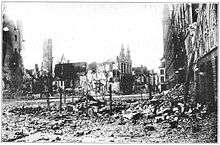
By the end of the battle the Ypres salient was compressed, with Ypres closer to the line. The city, bombarded by artillery fire, was demolished. Although poison gas had been used on the Eastern Front, it surprised the Allies and about 7,000 gas casualties were transported in field ambulances and treated in casualty clearing stations. In May and June, 350 British deaths were recorded from gas poisoning.[32] Both sides developed gas weapons and counter-measures, which changed the nature of gas warfare; the French and British used gas at the Battle of Loos in late September.[33] Gas protection was somewhat improved with the issue of improvised respirators made from cotton waste pads impregnated with sodium hyposulphite, sodium bicarbonate and glycerin. The respirators made little difference, however, due to lack of training and the use of local contraptions and poorly-made items imported from Britain. The "P helmet" (or "Tube Helmet") soaked in sodium phenate was issued by December 1915, and the PH helmet (effective against phosgene) was issued in early 1916.[34]
Although the Canadian division mounted an effective defense, it lost 5,975 men by its withdrawal on 3 May. The division was unprepared for the warfare prevailing on the Western Front, where linear tactics were ineffective against attackers armed with magazine rifles and machine guns. The Canadian field artillery had been effective, but the deficiencies of the Ross rifle worsened tactical difficulties. The Canadian Division received several thousand replacements shortly after the battle.[35][Note 4]
Casualties
After the war, German casualties from 21 April to 30 May were recorded as 34,933 by the Official historians of the Reichsarchiv. In the British Official History, J. E. Edmonds and G. C. Wynne recorded British losses of 59,275 casualties, among whom was Viscount Wendover, the only son of the 1st Marquess of Lincolnshire;[37] the French about 18,000 casualties on 22 April and another 3,973 from 26–29 April.[1][2] Canadian casualties from 22 April to 3 May were 5,975, of whom about 1,000 men were killed. The worst day was 24 April, when 3,058 casualties were sustained during infantry attacks, artillery bombardments and gas discharges.[3]
Subsequent operations
An operation known as the First Attack on Bellewaarde was conducted by the 3rd Division of V Corps on 16 June 1915 and the Second Attack on Bellewaarde, a larger operation, was conducted by the 3rd Division and the 14th Division of VI Corps from 25–26 September 1915. The Battle of Mont Sorrel, south of Ypres with the 20th Division of XIV Corps and the 1st, 2nd and 3rd Canadian divisions of the Canadian Corps, took place from 2–13 June 1916.[38] The Third Battle of Ypres, also known as the Battle of Passchendaele, was fought from July to November in 1917.[39]
Commemoration
Canadian participation in the Battle of Gravenstafel is commemorated on the Saint Julien Memorial in the village. During the Second Battle of Ypres, Lt. Col. John Alexander McCrae M.D. of Guelph wrote "In Flanders Fields" in the voice of those who perished in the war. Published in Punch 8 December 1915, the poem is still recited on Remembrance Day and Memorial Day.[40][41]
Lance Sergeant Elmer Cotton described the effects of chlorine gas in 1915:
It produces a flooding of the lungs – it is an equivalent death to drowning only on dry land. The effects are these – a splitting headache and terrific thirst (to drink water is instant death), a knife edge of pain in the lungs and the coughing up of a greenish froth off the stomach and the lungs, ending finally in insensibility and death. The colour of the skin from white turns a greenish black and yellow, the colour protrudes and the eyes assume a glassy stare. It is a fiendish death to die.[42]
Victoria Cross recipients
- Lance Sergeant D. W. Belcher, London Rifle Brigade (TF), 11th Brigade, 4th Division[43]
- Captain E. D. Bellew, 7th Battalion, British Columbia Regiment, 2nd Canadian Brigade, 1st Canadian Division[44]
- Jemadar Mir Dast, 55th Rifles (att. 57th Rifles), Ferozepore Brigade, Lahore Division[45]
- Lance Corporal F. Fisher, 13th Battalion Royal Highlanders of Canada, 3rd Canadian Brigade, 1st Canadian Division[18]
- Company Sergeant-Major F. W. Hall, 8th Battalion, Winnipeg Rifles, 2nd Canadian Brigade[46]
- Private J. Lynn, 2nd Lancashire Fusiliers, 12th Brigade, 4th Division[47]
- 2nd Lieutenant W. B. Rhodes-Moorhouse, 2 Squadron, Royal Flying Corps[48]
- Captain F. A. C. Scrimger, (Canadian Army Medical Service), 14th Battalion, Royal Montreal Regiment[49]
- Corporal I. Smith, 1st Manchesters, Jullundur Brigade, Lahore Division[45]
- Private E. Warner, 1st Bedfordshires, 15th Brigade, 5th Division[50]
See also
- First Battle of Ypres
- Use of poison gas in World War I
- Saint Julien Memorial
- Third Battle of Ypres
- List of Canadian battles during World War I
- Langford Wellman Colley-Priest
Notes
- ↑ The order is attributed to a Medical Officer, Capt. F.A.C. Scrimger.[20] Memoirs of two individuals at the battle do not recount this episode (see Nasmith, 1917 and Scott, 1922), though Nasmith, a chemist and bacteriologist who was commissioned in the C.A.M.C. as a laboratory and sanitation officer, recognized the gas on sight as chlorine and the following day began work on devising an effective way to counteract the gas. Urea in urine would react with chlorine, neutralising it by forming dichlorourea. See Chattaway (1908).
- ↑ Chlorine gas destroyed the respiratory organs of its victims and this led to a slow death by asphyxiation. One nurse described the death of one soldier who had been in the trenches during a chlorine gas attack. "He was sitting on the bed, fighting for breath, his lips plum coloured. He was a magnificent young Canadian past all hope in the asphyxia of chlorine. I shall never forget the look in his eyes as he turned to me and gasped: I can’t die! Is it possible that nothing can be done for me?" Chlorine made the victim cough and therefore limited his intake of the poison. Both sides found that phosgene was more effective, since only a small amount was needed to make it impossible for the soldier to keep fighting. It also killed its victim within 48 hours of the attack.
- ↑ The picture in the top right of this article depicts Princess Patricia's Canadian Light Infantry as they fought to halt the German attack on Frezenberg. The original mural hangs in the Senate of the main Parliament Building in Ottawa, Ontario, Canada. In the battle, 2/3 of the regiment were either killed or wounded and all but two two officers were killed or wounded in the battle. By the end of the battle, the regiment was commanded by a lieutenant.
- ↑ Another Canadian division joined the British Expeditionary Force in late 1915, joined eventually by two more in 1916. The battle also blooded many commanders, singling out some for praise, such as brigade commander Arthur Currie, and others for criticism, such as Garnet Hughes. The inadequacies of training and doctrine in the early CEF was made obvious by the antique tactics used at Kitcheners' Wood and St. Julien, though tactics in the British Colonial armies would be slow to evolve. At Second Ypres, the smallest tactical unit in the infantry was a company; by 1917 it would be the section. The Canadians were employed offensively later in 1915, but not successfully. The battle was the beginning of a long period of analysis and experiment to improve the effectiveness of Canadian infantry weapons, artillery and liaison between infantry and artillery.[36]
Footnotes
- 1 2 Sheldon 2012, p. 116.
- 1 2 Edmonds & Wynne 1927, pp. 359, 284.
- 1 2 Rawling 1992, p. 35.
- ↑ "Zweite Flandernschlacht (In German)". lexikon-erster-weltkrieg.de. 2 September 2015. Retrieved 3 September 2015.
- ↑ Edmonds & Wynne 1927, pp. 171–358.
- ↑ Edmonds & Wynne 1927, pp. 375–376.
- ↑ Edmonds & Wynne 1927, pp. 370–374.
- ↑ Edmonds & Wynne 1927, pp. 176–178.
- ↑ Croddy 2002, pp. 143–144.
- ↑ Edmonds & Wynne 1927, pp. 177–178.
- ↑ French 1915, pp. 6787–6789.
- ↑ Hossack, Anthony R. (22 August 2009). "The First Gas Attack". First World War.com. Retrieved 2 November 2014.
- ↑ Reichsarchiv 1932, p. 41.
- ↑ Edmonds & Wynne 1927, p. 183.
- ↑ Edmonds & Wynne 1927, pp. 178–185.
- ↑ Edmonds & Wynne 1927, pp. 185–187.
- 1 2 3 4 "2nd Battle of Ypres", Spartacus Educational
- 1 2 Edmonds & Wynne 1927, p. 178.
- ↑ Edmonds & Wynne 1927, p. 195.
- ↑ Legion Magazine
- ↑ Edmonds & Wynne 1927, pp. 214–239.
- ↑ Edmonds & Wynne 1927, pp. 240–255.
- ↑ Edmonds & Wynne 1927, pp. 256–268.
- ↑ Edmonds & Wynne 1927, p. 219.
- ↑ Edmonds & Wynne 1927, pp. 220–225.
- 1 2 Edmonds & Wynne 1927, pp. 217–218.
- ↑ Edmonds & Wynne 1927, p. 310.
- ↑ Edmonds & Wynne 1927, pp. 311–326.
- ↑ Edmonds & Wynne 1927, p. 340.
- ↑ Edmonds & Wynne 1927, pp. 340–3353.
- ↑ Edmonds & Wynne 1927, pp. 353–359.
- ↑ MacPherson et al. 1923, pp. 271–274.
- ↑ Edmonds 1928, pp. 150, 178.
- ↑ MacPherson et al. 1923, pp. 274–277.
- ↑ Rawling 1992, pp. 29–41.
- ↑ Rawling 1992, pp. 35–36.
- ↑ "Viscount Wendover Dead". The Register (Adelaide). LXXX, (21,381). South Australia. 21 May 1915. p. 6. Retrieved 26 February 2016 – via National Library of Australia.
- ↑ James 1924, pp. 8–9.
- ↑ Edmonds 1948, pp. 124–386.
- ↑ "John McCrae (from Historica)". Histori.ca. Retrieved 26 May 2011.
- ↑ David Evans (28 January 1918). "John McCrae (from the Canadian Encyclopedia)". Thecanadianencyclopedia.com. Retrieved 26 May 2011.
- ↑ Marion Girard (1 June 2008). A strange and formidable weapon: British responses to World War I poison gas. U of Nebraska Press. pp. 13–. ISBN 978-0-8032-2223-6. Retrieved 26 May 2011.
- ↑ Edmonds & Wynne 1927, p. 333.
- ↑ Edmonds & Wynne 1927, p. 221.
- 1 2 Edmonds & Wynne 1927, p. 260.
- ↑ Edmonds & Wynne 1927, p. 227.
- ↑ Edmonds & Wynne 1927, p. 290.
- ↑ Edmonds & Wynne 1927, p. 265.
- ↑ Edmonds & Wynne 1927, p. 252.
- ↑ Edmonds & Wynne 1927, p. 289.
References
Books
- Cassar, G. H. (2010). Hell in Flanders Fields: Canadians at the Second Battle of Ypres. Dundurn Press. ISBN 978-1-55488-728-6.
- Croddy, E. (2002). Chemical and Biological Warfare: A Comprehensive Guide for the Concerned Citizen. Copernicus Books. ISBN 0-387-95076-1.
- Militärischen Operationen zu Lande: Die Operationen des Jahres 1915. Die Ereignisse im Westen im Frühjahr und Sommer, im Osten vom Frühjahr bis zum Jahresschluß [Military Operations on land: The Operations of 1915. The events in the West in the Spring and Summer, in the East from the Spring up to the end of the Year]. Der Weltkrieg 1914 bis 1918: Militärischen Operationen zu Lande [The World War 1914–1918: Military Operations on land]. VIII (Die digitale landesbibliotek Oberösterreich online ed.). Berlin: Mittler. 2012 [1932]. OCLC 838300036. Retrieved 25 November 2013.
- Edmonds, J. E.; Wynne, G. C. (1995) [1927]. Military Operations France and Belgium, 1915: Winter 1915: Battle of Neuve Chapelle: Battles of Ypres. History of the Great War Based on Official Documents by Direction of the Historical Section of the Committee of Imperial Defence. I (Imperial War Museum and Battery Press ed.). London: Macmillan. ISBN 978-0-89839-218-0.
- Edmonds, J. E. (1928). Military Operations France and Belgium, 1915: Battles of Aubers Ridge, Festubert, and Loos. History of the Great War Based on Official Documents by Direction of the Historical Section of the Committee of Imperial Defence. II (1st ed.). London: Macmillan. OCLC 58962526.
- Edmonds, J. E. (1991) [1948]. Military Operations France and Belgium 1917: 7 June – 10 November. Messines and Third Ypres (Passchendaele). History of the Great War Based on Official Documents by Direction of the Historical Section of the Committee of Imperial Defence. II (Imperial War Museum and Battery Press ed.). London: HMSO. ISBN 0-89839-166-0.
- James, E. A. (1990) [1924]. A Record of the Battles and Engagements of the British Armies in France and Flanders 1914–1918 (London Stamp Exchange ed.). Aldershot: Gale & Polden. ISBN 0-948130-18-0.
- MacPherson, W. G.; Herringham, W. P.; Elliott, T. R.; Balfour, A. (1923). Medical Services: Diseases of the War, Including the Medical Aspects of Aviation and Gas Warfare and Gas Poisoning in Tanks and Mines (PDF). History of the Great War Based on Official Documents by Direction of the Historical Section of the Committee of Imperial Defence. II. London: HMSO. OCLC 769752656. Retrieved 1 December 2013.
- Nasmith, G. G. (1917). On the Fringe of the Great Fight. Toronto: McClelland, Goodchild & Stewart. OCLC 5298462. Retrieved 24 March 2014.
- Rawling, B. (1992). Surviving Trench Warfare: Technology and the Canadian Corps, 1914–1918. London: University of Toronto Press. ISBN 0-8020-6002-1.
- Scott, F. G. (1922). The Great War as I Saw It. Toronto: Goodchild. Retrieved 24 March 2014.
- Sheldon, J. (2012). The German Army on the Western Front 1915. Barnsley: Pen and Sword Military. ISBN 978-1-84884-466-7.
- Journals
- Chattaway, F. D. (1908). "The Action of Chlorine upon Urea Whereby a Dichloro Urea is Produced". Proceedings of the Royal Society A. 81 (549): 381–388. doi:10.1098/rspa.1908.0094. ISSN 0962-8452. JSTOR 93011.
- Chattaway, F. D. (1916). "Captain F. A. C. Scrimger, V.C.". Canadian Medical Association Journal. 6 (4): 334–336. ISSN 0820-3946. PMC 1584589
 . PMID 20310777.
. PMID 20310777. - Howell, W. B. (1938). "Colonel F.A.C. Scrimger, V.C." (PDF). Canadian Medical Association Journal. 38 (3): 279–281. ISSN 0820-3946. PMC 536406
 . Retrieved 19 December 2014.
. Retrieved 19 December 2014. - Love, D. (1996). "The Second Battle of Ypres, April 1915". Sabretasche. 26 (4). ISSN 0048-8933.
- Websites
- "Supplement to the London Gazette: 10 May 1915". Harrison and Sons. 1915. ISSN 0261-8575. OCLC 67823031. Retrieved 3 December 2013.
Further reading
- Croddy, E.; Wirtz, J. J. (2005). Weapons of Mass Destruction: an Encyclopaedia of Worldwide Policy, Technology and History. ABC-CLIO. ISBN 978-1-85109-490-5.
- Hobbes, N. (2003). Essential Militaria. Atlantic Books. ISBN 978-1-84354-229-2.
- Nicholson, G. W. L. (1962). Canadian Expeditionary Force 1914–1919 (PDF). Official History of the Canadian Army in the First World War. Ottawa: Queen's Printer and Controller of Stationary. OCLC 557523890. Retrieved 3 November 2014.
External links
| Wikimedia Commons has media related to Second Battle of Ypres. |
- Kitchener's Wood Memorial
- Second Battle of Ypres Overview
- Historical film documents on the Battles of Ypres
- Order of Battle
- Chlorine, Ucc.ie
- 4th Territorial Battalion, Northumberland Fusiliers
- Legion Magazine Online